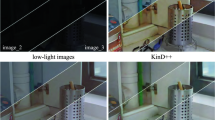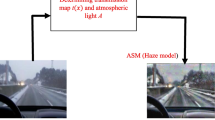Abstract
The haze phenomenon exerts a degrading effect that decreases contrast and causes color shifts in outdoor images and videos. The presence of haze in outdoor images and videos is bothersome, unpleasant, and occasionally, even dangerous. Atmospheric light scattering (ALS) model is widely used to restore hazy images. In this model, two unknown parameters should be estimated: airlight and scene transmission. The quality of dehazed images and video frames considerably depends on those two parameters as well as on the speed and accuracy of the refinement process of the approximated scene transmission, this refinement is necessary to ensure spatial coherency of the output dehazed video. Spatial coherency should be accounted for in order to eliminate flickering artifacts usually noticed when extending single-image dehazing methods to the video scenario. Classic methods typically require high computation capacity in order to dehaze videos in real time. However, when the driver assistance context is considered, these approaches are inappropriate due to the limited resources mobile environments usually have. To address this issue, this study proposes a framework for real-time video dehazing. This framework consists of two stages: single-image dehazing using the bounded transmission (BT) method, which is utilized to dehaze single video frame in real time with high accuracy; and transmission refinement stage using a filter we call controlled Gaussian filter (CGF), which is proposed for the linear and simplified refinement of the scene transmission. To evaluate the proposed framework, three image datasets in addition to two video streams are employed. Experimental results show that the single-image stage in the proposed framework is at least seven times faster than existing methods. In addition, the analysis of variance (ANOVA) test proves that the quality of dehazed images in this stage is statistically similar to or better than those obtained using existing methods. Also, experiments show that the video stage in the proposed framework is capable of real-time video dehazing with better quality than the existing methods.
























Similar content being viewed by others
Abbreviations
- BT:
-
Bounded Transmission
- Dehazing:
-
Scene restoration from haze and similar phenomena effects
- ALS:
-
Airlight scattering
- CGF:
-
Controlled Gaussian filter
- AL:
-
Atmospheric light, airlight or ambient light
- RGB:
-
Red, green and blue color space
- DCP:
-
Dark channel prior
- fps:
-
Frames per second
- IV-M:
-
Images and videos captured in Malaysia
- FRIDA:
-
Foggy road image database
- BRISQUE:
-
Blind referenceless image spatial quality evaluator
- NR IQA:
-
No-reference image quality assessment
- FR IQA:
-
Full-reference image quality assessment
- RR IQA:
-
Reduced-reference image quality assessment
- MAD:
-
Mean absolute difference
- ALII:
-
Airlight by image integral
- MANOVA:
-
Multivariate analysis of variance
- ANOVA:
-
Analysis of variance
- PA:
-
Planar assumption
- MOS:
-
Mean opinion score
- PLCC:
-
Pearson linear correlation coefficient
- SRCC:
-
Spearman’s rank-order correlation coefficient
- WMF:
-
Weighted median filter
- DoG:
-
Difference of Gaussians
- MSE:
-
Mean square error
- OpenCV:
-
Open computer vision library
References
Al-Zubaidy Y, Salam RA, Abdulrahim K. (2014). Estimation of skylight value in hazy outdoor images. In 2014 World Symposium on Computer Applications & Research (WSCAR), (pp. 1–5). IEEE
Fattal R. (2008) Single image dehazing. ACM Transactions on Graphics (TOG). ACM, 72
Gibson KB, Vo DT, Nguyen TQ (2012) An investigation of dehazing effects on image and video coding. IEEE Transactions on Image Processing (IEEE) 21:662–673
Hautière N, Tarel J-P, Aubert D, Dumont E (2008) Blind contrast enhancement assessment by gradient ratioing at visible edges. Image Analysis & Stereology Journal 27(2):87–95
He K, Sun J (2015) Fast guided filter. Computer Vision and Pattern Recognition pp1–3
He K, Sun J, Tang X (2011) Single image haze removal using dark channel prior. IEEE Trans Pattern Anal Mach Intell 33:2341–2353
He K, Sun J, Tang X (2013) Guided image filtering. IEEE Trans Pattern Anal Mach Intell 35:1397–1409
Hu Y, Wang N, Tao D, Gao X, Li X (2016) SERF: a simple, effective, robust, and fast image super-resolver from cascaded linear regression. IEEE Trans Image Process 25(9):4091–4102
ITU Report BT.1082-1 (1990) Studies towards the unification of picture assessment methodology. ITU, Geneva
Jisha J, Wilsky M. (2008) Enhancement of Weather degraded video sequences using wavelet fusion. 7th IEEE International Conference on Cybemetic Intelligent Systems. 1–6
Kim J-H, Jang W-D, Sim J-Y, Kim C-S (2013) Optimized contrast enhancement for real-time image and video dehazing. J Vis Commun Image Represent 24(3):410–425
Koschmieder H (1924). Theories der horizontalen sichtweite. p. 171–181
Lee S et al (2016) A review on dark channel prior based image dehazing algorithms. EURASIP Journal on Image and Video Processing 2016(1):1–23
McCartney EJ (1976). Optics of the atmosphere: scattering by molecules and particles New York, John Wiley and Sons, Inc Geophysics 1, 421
Middleton W (1952) Vision through the atmosphere. University of Toronto Press, Toronto
Mittal A, Moorthy AK, Bovik AC (2012) No-reference image quality assessment in the spatial domain. IEEE Trans Image Process 21(12):4695–4708
Narasimhan SG, Nayar SK (2003) Contrast restoration of weather degraded images. IEEE Trans Pattern Anal Mach Intell 25(6):713–724
Pedone M, Heikkilä J. (2011) Robust airlight estimation for haze removal from a single image. 2011 I.E. Computer Society Conference on Computer Vision and Pattern Recognition Workshops (CVPRW). IEEE, 90–96
Phan T, Sohoni S, Chandler DM, Larson EC (2012) Performance-analysis-based acceleration of image quality assessment. 2012 I.E. Southwest Symposium on Image Analysis and Interpretation (SSIAI). IEEE, 81–84
Rec. ITU-R BT.500-13 (2012). Recommendation: Methodology for the subjective assessment of the quality of television pictures. international telecommunication union
Shepard FD (1996) Reduced visibility due to fog on the highway. 228. Transportation Research Board
Shiau Y-H, Yang H-Y, Chen P-Y, Chuang Y-Z (2013) Hardware implementation of a fast and efficient haze removal method. Circuits and Systems for Video Technology, IEEE Transactions on 23:1369–1374
Tan RT (2008) Visibility in bad weather from a single image. IEEE Conference on Computer Vision and Pattern Recognition, 2008. CVPR 2008. IEEE, 1–8
Tarel J-P, Hautiere N (2009) Fast visibility restoration from a single color or gray level image. 2009 I.E. 12th International Conference on Computer Vision. IEEE, 2201–2208
Tarel J-P, Hautiere N, Cord A, Gruyer D, Halmaoui H. (2010). Improved visibility of road scene images under heterogeneous fog. Intelligent Vehicles Symposium (IV), 2010 I.E. (pp. 478–485). IEEE
Tomasi C, Manduchi R (1998). Bilateral Filtering for Gray and Color Images". Sixth International Conference on Computer Vision, 1998. p. 839–846. IEEE
Viola P, Jones M (2001) Robust real-time object detection. Int J Comput Vis 4:51–52
VQEG (2000) final report from the video quality experts group on the validation of video quality assessment. VQEG
Wang N, Gao X, Sun L, Li J (2017) Bayesian face sketch synthesis. IEEE Trans Image Process 26(3):1264–1274
Wang N, Gao X, Sun L, Li J (2017). Anchored neighborhood index for face sketch synthesis. IEEE Transactions on Circuits and Systems for Video Technology 99:1–6
Wilscy M, John J (2008) A novel wavelet fusion method for contrast correction and visibility enhancement of color images. Proceedings of the World Congress on Engineering 1:2–4
Winnemoller H, Kyprianidis JE, Olsen SC (2012) XDoG: an extended difference-of-Gaussians compendium including advanced image stylization. Comput Graph 36(6):740–753
Zhang Q, Xu L, Jia J (2014) 100+ times faster weighted median filter (WMF). 2014 I.E. Conference on Computer Vision and Pattern Recognition (CVPR). IEEE, 2830–2837
Author information
Authors and Affiliations
Corresponding author
Ethics declarations
Conflict of interest
The authors declare that they have no competing interests.
Rights and permissions
About this article
Cite this article
Alajarmeh, A., Zaidan, A.A. A real-time framework for video Dehazing using bounded transmission and controlled Gaussian filter. Multimed Tools Appl 77, 26315–26350 (2018). https://doi.org/10.1007/s11042-018-5861-4
Received:
Revised:
Accepted:
Published:
Issue Date:
DOI: https://doi.org/10.1007/s11042-018-5861-4









